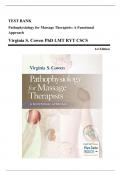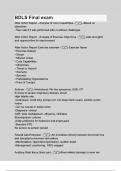TEST BANK
Pathophysiology for Massage Therapists: A Functional
Approach
Virginia S. Cowen PhD LMT RYT CSCS
1st Edition
,Table of Contents
Chapter 01 Introduction to Pathophysiology 1
Chapter 02 Determinants of Health 7
Chapter 03 Massage, Health, and Disease 14
Chapter 04 Inflammation, Injury, and Tissue Remodeling 21
Chapter 05 Understanding Pain 27
Chapter 06 Let’s Talk About Stress 33
Chapter 07 Infection and Immunity 39
Chapter 08 Understanding Cancer 45
Chapter 09 Autoimmune Disorders 51
Chapter 10 Movement Structure and Function 56
Chapter 11 Neuromuscular Conditions 62
Chapter 12 Overuse and Recovery Disorders 68
Chapter 13 Degenerative Neuromuscular Disorders and Diseases 74
Chapter 14 Bone, Joint, and Postural Disorders 81
Chapter 15 Circulatory and Cardiorespiratory Structure and Function 87
Chapter 16 Cardiovascular Disorders 92
Chapter 17 Respiratory Conditions 99
Chapter 18 Lymphatic and Immune Disorders 105
Chapter 19 Digestion and Elimination Structure and Function 112
Chapter 20 Digestive Disorders 118
Chapter 21 Elimination Disorders 124
Chapter 22 Metabolic and Reproductive Structure and Function 130
Chapter 23 Metabolic Disorders 136
Chapter 24 Nutrient Balance Disorders 142
Chapter 25 Reproductive Disorders 148
Chapter 26 The Brain, Behavior, and Sensation Structure and Function 154
Chapter 27 Sensory Disorders 160
Chapter 28 Cognitive and Emotional Disorders 166
Chapter 29 Psychosomatic Disorders 172
Chapter 30 Connective Tissue and Integumentary Structure and Function 178
Chapter 31 Connective Tissue and Contracture Disorders 184
Chapter 32 Dematologic Disorders 190
Chapter 33 Development 197
Chapter 34 Developmental Disabilities 202
Chapter 35 Birth Defects 208
Chapter 36 Clinical Decision Making 214
Chapter 37 Common Multiple Morbidities 219
,______________________________________________________________________________________________
Test Bank - Pathophysiology for Massage Therapists: A Functional Approach, 1st Edition (Cowen, 2016)
Chapter 1: Introduction to Pathophysiology
MULTIPLE CHOICE
1. The study of how disease or injury affects physical, chemical, and mechanical operations of
the body is defined as:
A. pathology.
B. pathophysiology.
C. etiology.
D. physiology.
ANS: B
Pathophysiology is the study of how disease or injury affects physical, chemical, and
mechanical operations of the body.
PTS: 1 TOP: Pathology KEY: Definition of Pathophysiology
2. Which medical specialty analyzes alterations in the tissues of the body that are caused by
disease or injury?
A. Pathology
B. Pathophysiology
C. Psychology
D. Physiology
ANS: A
Pathology is a medical specialty that analyzes alterations in the tissues of the body that are
caused by disease or injury.
PTS: 1 TOP: Pathology KEY: Definition of Pathology
3. The study of origins and causes of diseases is called:
A. pathology.
B. etiology.
C. kinesiology.
D. pathophysiology.
ANS: B
The study of origins and causes of diseases is called etiology.
PTS: 1 TOP: Pathology KEY: Definition of Etiology
4. A broad approach when attempting to understand how the body responds to change that is
caused by disease or injury is referred to as:
A. etiology.
B. pathology.
C. pathophysiology.
D. kinesiology.
ANS: C
______________________________________________________________________________________________
1|Page
,______________________________________________________________________________________________
Test Bank - Pathophysiology for Massage Therapists: A Functional Approach, 1st Edition (Cowen, 2016)
Pathophysiology is the study of how disease or injury affects physical, chemical, and
mechanical operations of the body (see Fig. 1.1). The topic of pathophysiology arises from the
field of pathology. Pathology is a medical specialty that analyzes alterations in the tissues of
the body that are caused by disease or injury. In other words, pathophysiology takes a broader
approach by attempting to understand how the body responds to change that is caused by
disease or injury.
PTS: 1 TOP: Pathology KEY: Definition of Pathophysiology
5. Holistic health focuses on:
A. physiology only.
B. psychology only.
C. anatomy only.
D. the whole person.
ANS: D
The practice of massage is holistic in nature. Whereas a medical pathologist works with body
tissues, the massage therapist works with the whole person.
PTS: 1 TOP: Massage Theory and Application | Massage Benefits and Techniques
KEY: Definition of Holistic
6. Massage therapy utilizes which of the following approaches to health?
A. Holistic
B. Psychological
C. Anatomical
D. Kinesthetic
ANS: A
The practice of massage is holistic in nature. Whereas a medical pathologist works with body
tissues, the massage therapist works with the whole person.
PTS: 1 TOP: Massage Theory and Application | Massage Benefits and Techniques
KEY: Massage Focus | Holistic
7. An impairment, sickness, illness, or affliction that interferes with the normal function of the
body is referred to as which of the following?
A. Syndrome
B. Disorder
C. Condition
D. Entrapment
ANS: B
A health-related disorder is any impairment, sickness, illness, or affliction that interferes with
the normal function of the body.
PTS: 1 TOP: Pathology KEY: Definition of Disorder
8. A disorder can be broken down into what two categories?
A. Disease, injury
B. Condition, injury
______________________________________________________________________________________________
2|Page
,______________________________________________________________________________________________
Test Bank - Pathophysiology for Massage Therapists: A Functional Approach, 1st Edition (Cowen, 2016)
C. Disease, condition
D. Entrapment, disease
ANS: A
Disorders can be placed into two broad categories: disease and injury.
PTS: 1 TOP: Pathology KEY: Disorder Categories
9. Which of the following are considered to be caused by destructive elements (e.g., pathogens)?
A. Injuries
B. Conditions
C. Diseases
D. Symptoms
ANS: C
Diseases are considered to be caused by destructive elements (e.g., pathogens).
PTS: 1 TOP: Pathology KEY: Cause of Disease
10. Which of the following terms generally refers to damage that is caused by an internal or
external factor (e.g., a perforated ulcer, a stab wound)?
A. Injuries
B. Diseases
C. Symptoms
D. Conditions
ANS: A
lnjuries generally refers to damage that is caused by an internal or external factor (e.g., a
perforated ulcer, a stab wound).
PTS: 1 TOP: Pathology KEY: Definition of Injury
11. The objective, measureable aspects of assessing a disorder are referred to as:
A. symptoms.
B. diseases.
C. injuries.
D. signs.
ANS: D
Signs of disorders include objective evidence or externally visible indicators of a pathological
condition.
PTS: 1 TOP: Pathology | Assessment KEY: Identifying Signs
12. The subjective, unmeasurable aspects of assessing a disorder are referred to as:
A. symptoms.
B. diseases.
C. injuries.
D. signs.
ANS: A
______________________________________________________________________________________________
3|Page
,______________________________________________________________________________________________
Test Bank - Pathophysiology for Massage Therapists: A Functional Approach, 1st Edition (Cowen, 2016)
Symptoms are subjective experiences that suggest or indicate a disorder. They are based on
personal perceptions and experiences.
PTS: 1 TOP: Pathology | Assessment
KEY: Identifying Symptoms
13. Fever is an example of which of the following?
A. Symptom
B. Disease
C. Injury
D. Sign
ANS: D
A fever is elevated body temperature. It is a sign that can be measured with a thermometer.
PTS: 1 TOP: Pathology | Assessment KEY: Example of Signs
14. Chills and aching are examples of which of the following?
A. Symptoms
B. Diseases
C. Injuries
D. Signs
ANS: A
Symptoms of fever include aches, chills, fatigue, and loss of appetite.
PTS: 1 TOP: Pathology | Assessment
KEY: Examples of Symptoms
15. The collective presentation of signs and symptoms indicate, suggest, or identify a pathological
condition. What is this called?
A. Sign
B. Diagnosis
C. Symptom
D. Syndrome
ANS: B
The collective presentation of signs and symptoms indicate, suggest, or identify a pathological
condition. This is called a diagnosis.
PTS: 1 TOP: Pathology | Assessment
KEY: Definition of Diagnosis
16. A massage therapist may NOT perform which of the following?
A. Manipulation of soft tissue
B. Palpation
C. Joint mobilization
D. Diagnosis
ANS: D
______________________________________________________________________________________________
4|Page
,______________________________________________________________________________________________
Test Bank - Pathophysiology for Massage Therapists: A Functional Approach, 1st Edition (Cowen, 2016)
A medical diagnosis must be performed by a physician or other health-care practitioner who is
licensed to diagnose medical conditions. The scope of practice for massage therapists does not
include medical diagnosis.
PTS: 1 TOP: Pathology | Assessment KEY: Diagnosis
17. A disorder whose cause cannot be fully traced is known as what?
A. Disease
B. Syndrome
C. Sign
D. Symptom
ANS: B
A syndrome is a group of signs and symptoms that occur together and indicate a potential
disorder. The presentation of a syndrome is suggested by the pattern of these signs and
symptoms.
PTS: 1 TOP: Pathology KEY: Syndrome
18. Which field encourages people to take control over improving their own health and
well-being?
A. Health assessment
B. Medical care
C. Health promotion
D. Behavioral medicine
ANS: C
Health promotion is a field that encourages people to take control over improving their own
health and well-being.
PTS: 1 TOP: Pathology KEY: Health and Well-Being
19. Screening tools that evaluate individual health are referred to as:
A. primary prevention.
B. health risk assessments.
C. secondary prevention.
D. tertiary prevention.
ANS: B
Health risk appraisals are another form of health promotion. Sometimes called health risk
assessments, they are screening tools that evaluate individual health. Health risk appraisals
can range from simple to complex.
PTS: 1 TOP: Pathology | Assessment
KEY: Health Screenings | Risk Factors
20. Which type of prevention includes efforts to prevent a person from ever contracting a disease,
illness, or disorder?
A. Tertiary
B. Secondary
C. Optimal
______________________________________________________________________________________________
5|Page
, ______________________________________________________________________________________________
Test Bank - Pathophysiology for Massage Therapists: A Functional Approach, 1st Edition (Cowen, 2016)
D. Primary
ANS: D
Primary prevention includes efforts to prevent a person from ever contracting a disease,
illness, or disorder.
PTS: 1 TOP: Pathology KEY: Prevention | Wellness
21. Detection and diagnosis of a disorder is referred to as which of the following?
A. Primary prevention
B. Optimal prevention
C. Secondary prevention
D. Tertiary prevention
ANS: C
Secondary prevention involves detection and diagnosis. Early detection of a condition enables
a person to receive treatment before the disease has time to worsen.
PTS: 1 TOP: Pathology KEY: Prevention | Wellness
22. After a disorder is diagnosed, the treatment provided is referred to as which type of
prevention?
A. Optimal
B. Secondary
C. Primary
D. Tertiary
ANS: D
Tertiary prevention is any treatment that is given to a person who has been diagnosed with a
disease or disorder. This treatment includes efforts to treat symptoms, reduce potential
disability, and rehabilitate.
PTS: 1 TOP: Pathology KEY: Prevention | Wellness | Treatment
23. For different types of disorders, the involvement of massage therapy in a treatment plan may
be included in which of the following categories?
A. Primary and secondary
B. Secondary and tertiary
C. Primary and tertiary
D. Primary, secondary, and tertiary
ANS: D
Under different circumstances, massage therapy can be viewed as primary, secondary, or
tertiary prevention.
PTS: 1
TOP: Pathology | Assessment | Theory and Application | Benefits and Techniques
KEY: Massage Indications
______________________________________________________________________________________________
6|Page





